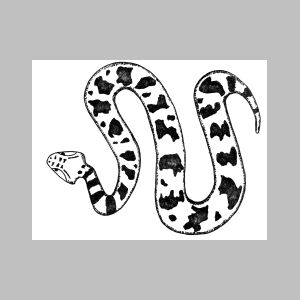Bulletin 1 - March 1977: Snakes
Snakes
by Bish BrownThe very mention of the word "snakes" sends a chilly feeling down the spines of most people. Why should this be so? Snakes are portrayed to children from an early age as something unpleasant and dangerous. This impression remains throughout life, as most people rarely see a live snake in the wild.
On land, two species of cobra and one species of viper have been reported from the Emirates. However, only the viper has been caught and positively identified. Five or six species of non-poisonous snakes have also been found. It is possible that the "cobras" that have been reported are actually a colubrid called Malpolon miolensis (Reuss), which often erects a cobra-like hood when defensive. This rear-fanged snake, known as the Arabian Rear-fang, though slightly poisonous, could not inject the fatal dose of poison that the cobra would inject.
The identification of snakes could help to lessen the fear when non-poisonous snakes are encountered unexpectedly on a desert trip. Illustrated here is the only known poisonous snake found in the United Arab Emirates; the Sand or Saw-scaled Viper.
The Sand Viper is of the family Viperidae, genus Cerastes Wagler and species Cerastes gasperetti (Laviton and Anderson).
DescriptionThe head is triangular in shape and covered with very small scales. The two long, hollow, injection fangs are situated at the front of the upper jaw connected to a poison sac. Poison is injected as the jaws are closed. Eyes are set well forward. The neck is very thin, expanding into a fairly thick body. The body is covered with large coarse scales that are rubbed together by coiling to make a loud "sssssh" when the snake is disturbed. Total length is up to 24 inches ending in a short thin tail. Some specimens develop a half-inch long protuberance over each eye -- the horned vipers.
ColorThe head is sand colored with yellowish-brown markings and a grayish-blue line over the eye to the back of the head. The body is light fawn with irregular yellowish-brown markings. The short tail is often yellow. Undersides are a yellowish-white. Colors can very depending on surroundings and may change slightly.
HabitatSandy deserts, where it lies partly covered by loose sand.
FoodAny small mammal, lizard or bird that ventures near enough to be caught.
Snakes will normally try to hide in a hole at the approach of a human. They will not normally attack unless a foot is inadvertently placed on or near the snake.
Do not pick up a snake you have not identified.
Always look ahead and wear strong shoes or boots when hiking in soft sand.
Always use a walking stick or broom handle to turn over pieces of debris. Never use your bare hands.
